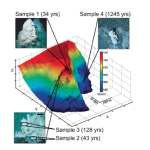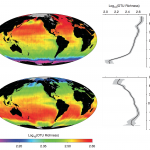Something to think about: the recent Gibbons et al. (2013) PNAS paper found that *one* site in the English Channel showed a 31.7-66.2% overlap in microbial communities when compared to any one of 356 datasets collected as part of the International Census of Marine Microbes (ICoMM). That’s a ridiculous overlap! As the paper title suggests, this gives us “Evidence for a persistent microbial seed bank throughout the global ocean.”
Microbe species don’t fuck around. They’re everywhere. You just have to sequence lots of DNA to find them all.
Except…some deep sea species were *only* found in the Deep Sea…
For example, the marine cold seep biome contributed OTUs [Operational Taxonomic Units, a.k.a putative “species” defined solely from DNA] from the Halanaerobiaceae family. This family includes anaerobic, halophylic species, which have been found to be highly abundant in hypersaline brine pools such as those associated with cold seeps (19); this comparison suggests that a number of Halanaerobiaceae OTUs in the cold seep biome were not detected in the L4 [English Channel] site.
…the marine hydrothermal vent samples contributed members of the Campylobacterales not detected in the L4-DeepSeq [English Channel] sample. Campylobacterales is an order within the e-proteobacteria that includes both free-living and host-associated chemolithotrophs, such as those associated with tube-worms surrounding hydrothermal vents (22).
This study was only looking at bacteria and archaea – no DNA from multicelled microbes – and I’m not sure how intensively the deep sea ICoMM samples were sequenced. But I’m becoming more and more convinced that the Deep Sea is an untapped Candy Cane forest of genomes. So much endemic DNA for us to frolic and play with!
We won’t find these genomes roving around at the surface – marine biologists need to focus more on genomic technologies to sequence the deep.
Reference: Gibbons SM, Caporaso JG, Pirrung M, Field D, Knight R, Gilbert JA. (2013) Evidence for a persistent microbial seed bank throughout the global ocean. Proceedings of the National Academy of Sciences, USA, 110(12):4651–5.





